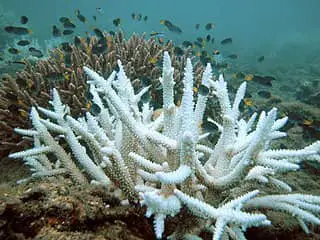What is coral bleaching? Is it a natural phenomenon or a product of climate change? Read on to know more about one effect of climate change that can change your life.
A greater understanding of ongoing changes in climate regime can help people take the steps to successfully adapt and survive. This article explores the consequences of one of the notable manifestations of climate change, i.e., increased sea surface temperature (SST) due to trapped greenhouse gases in the atmosphere.
The superfluous emission of greenhouse gases, particularly carbon dioxide into the atmosphere, has become a global cause of concern in the past few decades. The accumulated greenhouse gases lead to an overall increase in average global temperature (Meehl et al. 2007).
As a result, the ability of the global system to maintain a dynamic equilibrium appears to be compromised, as indicated by notable climate changes which are believed to be exacerbated by extant human activities.
Burning fossil fuels for electricity, the multitude of cars plying the streets, forest fires, whether natural or anthropogenic such as that recent fire caused by deforestation in the Amazon in 2022, all contribute to carbon dioxide in the atmosphere—these are primary sources of greenhouse emissions.
We can feel and observe changes in our climate, including increasing severity of storms or typhoons to warming of the surrounding environment, not only land but also the sea. Increased sea surface temperature affects the dwellers of the vast marine expanse—the oceans that comprise 71 percent of the Earth’s surface whose ecosystem services sustain the ever-growing human population.
In particular, how can increased sea surface temperature influence the lives of people dependent on the productivity of the coastal areas?
Here are studies that reveal the significance of this global phenomenon.
Effects of Climate Change on Coral Reefs: Increased Sea Surface Temperature
Increased SST can have significant impacts on marine life, especially in the tropics. These include primarily the diverse variety of corals, fishes, and other species living in the marine ecosystem.
The effect of increased SST presents problems with marine food web productivity and sustainability, especially in vulnerable locations and ecosystems. These effects include the direct effect of SST to coral reefs, specifically in terms of mass coral bleaching events that lead to consequential obliteration of biological processes founded on the productivity of healthy reef ecosystems.
Considering that marine organisms are closely interconnected and interrelated, the damage accorded by increased SST will have significant implications to the dynamics of the entire food web, which, as studies show, have more negative than positive impacts to reef life and society due to decreased fish productivity.
Coral Bleaching Effects
Wilkinson (2004) reported that coral reef bleaching due to increased sea temperatures lead to the destruction of reefs around the world. Reef bleaching results when the symbiotic zooxanthellae vital to coral reef metabolism and coloration is expelled from the body of the coral.
Zooxanthellae carries out photosynthesis and supplies the food needs of the coral polyp—the small creature that lives in the coral colony which can have a diameter of a pinhead to a foot. Lack of photosynthetic activity in the coral will eventually lead to coral death, i.e., if high sea surface temperature persists.
The picture below shows how coral bleaching occurs. The white coral colony in the foreground is the bleached, dead coral.

Because of reef damage as a result of coral bleaching, there will be a significant reduction in the diversity and abundance of reef fishes that feed on the small coral polyps and the materials of the coral reef (Wilson et al. 2008, Coker et al. 2009, Munday et al. 2009, Pratchett et al. 2009, Wilson et al. 2010).
This phenomenon occurs especially in vulnerable locations, such as those with structurally less complex systems (Graham et al. 2006). Up to 75% of fish species may decline in abundance within a 5-10-year period, including species which are not coral reef dependent (Munday 2008a).
Coral Bleaching Outcome
1. Reduced Fish Growth
Munday et al. (2008b) demonstrated in an experiment on a common coral-reef fish (Acanthochromis polyacanthus) that at an elevated temperature of 31 degrees Centigrade, the growth of fish declined. This means that temperature can restrict the growth in fish.
On a larger scale, this finding means that increased sea surface temperature can reduce the amount of biomass present in reef ecosystems, which will mean reduced fish productivity. This also means less food available for people dependent on what the coastal ecosystem provides.
High sea surface temperature can restrict the growth of fish. This implies less food available to people dependent on the coastal and marine ecosystem food production.
2. Reduced Availability of Nutrients
Another interesting finding is that an increase in SST makes sea waters more stable, hence, this prevents the important process of vertical mixing of large bodies of water that make nutrient available originating from the ocean bottom to the surface.
The lack of vertical mixing means that the upper surface of the sea will have fewer nutrients to start up the marine food chain. Reduced nutrient supply will mean less organic material available to start primary, photosynthetic production, which lies at the base of food chains supporting fisheries (Munday 2009).
Resiliency of Coral Reef Ecosystems
Many coral reef ecosystems are resilient to short-term increase in SST. Resiliency depends on many factors, including reef complexity; marine species biodiversity; presence of exacerbating human-induced factors; mobility of marine organisms, among others.
One of the foremost consideration of the SST problem lies in sustained, elevated sea temperature regimes that can exceed the tolerance level of coral reefs ecosystems, especially in the tropics. Thus, this possibly results in irreversible direct damage to coral reefs and overall imbalance in reef ecosystem.
Ultimately, the damage to the coral reefs will threaten the livelihood and very existence of people who largely depend on the goods and services this extensive section of the coasts provides. Humans, as the end-of-pipe recipient of such effect, will endure the consequences.
Applying the Precautionary Approach
Taking the precautionary approach stance in dealing with the global threat of climate change and coral bleaching as a negative effect, certain pro-active adaptation options may be adopted to reduce, if not eliminate, the negative consequences of increased sea surface temperature to coastal, fishery-based societies. There is a need to generate adaptive options that will cushion the effects of climate change.
References
Bell, J., Batty, M., Ganachaud, A., Gehrke, P., Hobday, A., Hoegh-Guldberg, O., Johnson, J., Le Borgne, R., Lehodey, P., Lough, J., Pickering, T., Pratchett, M., Sheaves, M., and M. Waycott (2010). Preliminary assessment of the effects of climate change on fisheries and aquaculture in the Pacific. In: Fisheries in the Economies of the Pacific Island Countries and Territories. Pacific Studies Series . Asian Development Bank, Manila, Philippines, pp. 451-469.
Coker, Darren J., Pratchett, Morgan S., and Munday, Philip L. (2009) Coral bleaching and habitat degradation increase susceptibility to predation for coral-dwelling fishes. Behavioral Ecology, 20 (6). pp. 1204-1210.
Graham, N.A.J., K.Wilson, S. Jennings, N.V.C. Polunin, J.P. Bijoux and J. Robinson (2006). Dynamic fragility of oceanic coral reef ecosystems. Proceedings of the National Academy of Sciences of the United States of America 103: 8425-8429.
Meehl, G.A. et al. (2007) Global Climate Projections. In: Climate Change 2007: The Physical Science Basis. Contribution of Working Group I to the Fourth Assessment Report of the Intergovernmental Panel on Climate Change [Solomon, S., D. Qin, M. Manning, Z. Chen, M. Marquis, K.B. Averyt, M.Tignor and H.L. Miller (eds.)]. Cambridge University Press, Cambridge, United Kingdom and New York, NY, USA.
Munday, P.L., G.P. Jones, M.S. Pratchett, and A. Williams (2008a). Climate change and the future for coral reef fishes. Fish and Fisheries 9: 261-285.
Munday, P.L., Kingsford, M., O’Callaghan, M. and Donelson, J.M. (2008b) Elevated temperature restricts growth potential of the coral reef fish Acanthochromis polyacanthus. Coral Reefs 27: 927-931.
Munday P.L., Cheal A.J., Graham N.A.J., Meekan M., Pratchett M.S., Sheaves M., Sweatman H. and Wilson S.K. (2009) Tropical Coastal Fish. In A Marine Climate Change Impacts and Adaptation Report Card for Australia 2009 (Eds. E.S. Poloczanska, A.J. Hobday and A.J. Richardson), NCCARF Publication 05/09, ISBN 978-1-921609-03-9.
Pratchett, M. S., Wilson, S. K., Graham, N. A. J., Jones, G. P., and N. V. C. Polunin (2009). Coral bleaching and consequences for motile reef organisms: past, present and uncertain future effects. Ecological Studies, Vol. 205, pp. 139-158.
Wilkinson, C. 2004. Status of coral reefs of the world: 2004, Vol. 1. Global Coral Reef Monitoring Network.
Wilson, S. K., Fisher, R. , Pratchett, M. S.. Graham, N. A. J., Dulvy, N. K., Turner, R. A., Cakacaka, A., Polunin, N. V. C. and S. P. Rushton (2008). Exploitation and habitat degradation as agents of change within coral reef fish communities. Global Change Biology.
Wilson, S. K., Fisher, R. , Pratchett, M. S.. Graham, N. A. J., Dulvy, N. K., Turner, R. A., Cakacaka, A., and N. V. C. Polunin (2010). Habitat degradation and fishing effects on the size structure of coral reef communities. Ecological Applications, 20(2), pp. 442.
© 2023 January 27 P. A. Regoniel
[cite]

